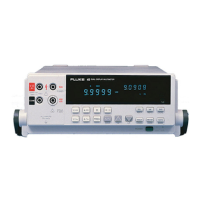45
Service Manual
5-10
5-4. General Troubleshooting Procedures
The Fluke 45 allows for some fault isolation using self-diagnostic routines and
descriptive error codes. However, these features are somewhat limited and do not
provide in-depth troubleshooting tools.
The Fluke 45 incorporates a semi-modular design; determining modules not related to a
problem constitutes the first step in the troubleshooting process. Disconnect the Battery
Option cable at the Main PCA. Disconnect the IEEE-488 Interface Option at P2 and P3
on the IEEE-488 Interface PCA. If either of these assemblies is causing the meter failure,
refer to troubleshooting information in Chapters 7 and 8 (7 for the Battery Pack Option,
8 for the IEEE-488 Interface Option.)
Measuring the power supplies helps to isolate a problem further. Refer to Table 5-2 and
Figure 5-1 for test point identification and readings. If power supply loading is
suspected, disconnect the Display PCA at J4 on the Main PCA. If this action solves the
loading problem, proceed to Display Assembly Troubleshooting elsewhere in this
chapter. Otherwise, refer to Power Supply Troubleshooting.
If the power supplies appear good, check the E clock signal to determine whether the
Main PCA or the Display PCA is causing the problem. A correct display depends on the
E clock signal. Missing segments, intensified digits, a strobing display, or a blank
display can be caused by a faulty E clock.
Use an oscilloscope to check for the E clock at microcomputer A1U6, pin 68. Look for a
921.6 kHz square wave that transitions from 0 to 5 V dc (VCC).
• If this signal is present, the problem is probably on the Display PCA. Refer to
Display Assembly Troubleshooting elsewhere in this chapter.
• If the E clock is something other than a 921.6 kHz square wave, isolate the digital
chapter of the Main PCA by disconnecting the Display PCA at J4. Then check the E
clock again, and refer to Digital Troubleshooting elsewhere in this chapter for
further problem isolation.
5-5. Power Supply Troubleshooting
5-6. Raw DC Supply
With the meter off (but connected to line power), check for approximately 16 V dc (at
120 V ac line voltage) between the ground test point and the cathode of either A1CR2 or
A1CR3. If necessary, check for transformer secondary voltage of approximately 24 V ac.
With the meter on, check for 19 V dc from A1U11, pin 8 to the ground test point. This
voltage is approximately 5 volts greater than the raw supply voltage when the switching
supply is operating properly. The controller IC, A1U11, starts operating when its supply
voltage is approximately 2.5 V dc.

